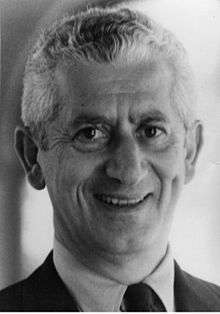Benjamin Bloom
Benjamin Samuel Bloom (February 21, 1913 – September 13, 1999) was an American educational psychologist who made contributions to the classification of educational objectives and to the theory of mastery learning. He is particularly noted for leading educational psychologists to develop the comprehensive system of describing and assessing educational outcomes in the mid-1950s.[1] He has influenced the practices and philosophies of educators around the world from the latter part of the twentieth century.
Benjamin Bloom | |
|---|---|
 Benjamin Bloom | |
| Born | Benjamin Samuel Bloom February 21, 1913 Lansford, Pennsylvania, US |
| Died | September 13, 1999 (aged 86) |
| Awards | E. L. Thorndike Award (1973) |
| Academic background | |
| Alma mater | |
| Academic work | |
| Discipline | Psychology |
| Sub-discipline | Educational psychology |
| Institutions | University of Chicago |
| Notable ideas | |
Early life and education
Bloom was born in Lansford, Pennsylvania, to an immigrant Jewish family. His parents fled a climate of discrimination in Russia.[2] Bloom's father supported the family as a tailor.[2]
Bloom studied at Pennsylvania State College and was awarded his bachelor's and master's degree by 1935.[1] He wished to study under Ralph Tyler, a progressive educator, so he enrolled in the doctoral program in education at the University of Chicago and assisted Tyler with the Eight-Year Study, which evaluated alternative methods of school assessment.[1]
Bloom earned his doctoral degree in 1942 and became a member of the University of Chicago's Board of Examiners.
Works
In 1956, Bloom edited the first volume of The Taxonomy of Educational Objectives: The Classification of Educational Goals, which classified learning objectives according to a rubric that has come to be known as Bloom's Taxonomy. It was one of the first attempts to systematically classify levels of cognitive functioning and gave structure to the otherwise amorphous mental processes of gifted students.[3] Bloom's Taxonomy remains a foundation of the academic profession according to the 1981 survey, "Significant Writings That Have Influenced the Curriculum: 1906–81" by Harold G. Shane and the National Society for the Study of Education. Bloom's 2 Sigma Problem is also attributed to him.
Aside from his work on educational objectives and outcomes, Bloom also directed a research team that evaluated and elucidated the process of developing exceptional talents in individuals, shedding light upon the phenomena of vocational eminence and the concept of greatness.[4]
References
- Kovalchick, Ann; Dawson, Kara (2004). Education and Technology: A-I. Santa Barbara, CA: ABC-CLIO. pp. 66. ISBN 1576073513.
- Bresler, Liora; Cooper, David; Palmer, Joy (2002). Fifty Modern Thinkers on Education: From Piaget to the Present Day. Oxon: Routledge. pp. 86. ISBN 041522408X.
- Karnes, Frances; Nugent, Stephanie (2004). Profiles of Influence in Gifted Education: Historical Perspectives and Future Directions. Waco, TX: Prufrock Press Inc. p. 18. ISBN 1882664973.
- Bloom, B. S., ed. (1985). Developing Talent in Young People. New York: Ballantine Books.
Further reading
- Bloom, Benjamin S. (1980). All Our Children Learning. New York: McGraw-Hill.
- Bloom, Benjamin S. Taxonomy of Educational Objectives (1956). Published by Allyn and Bacon, Boston, MA. Copyright (c) 1984 by Pearson Education.
- Bloom, B. S. (ed). (1985). Developing Talent in Young People. New York: Ballantine Books.
- Eisner, Eliot W. "Benjamin Bloom: 1913-1999." Prospects, the quarterly review of comparative education (Paris, UNESCO: International Bureau of Education), vol. XXX, no. 3, September 2000. Retrieved from http://www.ibe.unesco.org/publications/ThinkersPdf/bloome.pdf on April 10, 2009.
- Torsten Husén, Benjamin S. Bloom, in: Joy A. Palmer (ed), Fifty Modern Thinkers on Education: From Piaget to the Present Day, London - New York: Routledge, 2001, pp. 86–90.
External links
| Professional and academic associations | ||
|---|---|---|
| Preceded by Lee Cronbach |
President of the American Educational Research Association 1965–1966 |
Succeeded by Julian Stanley |